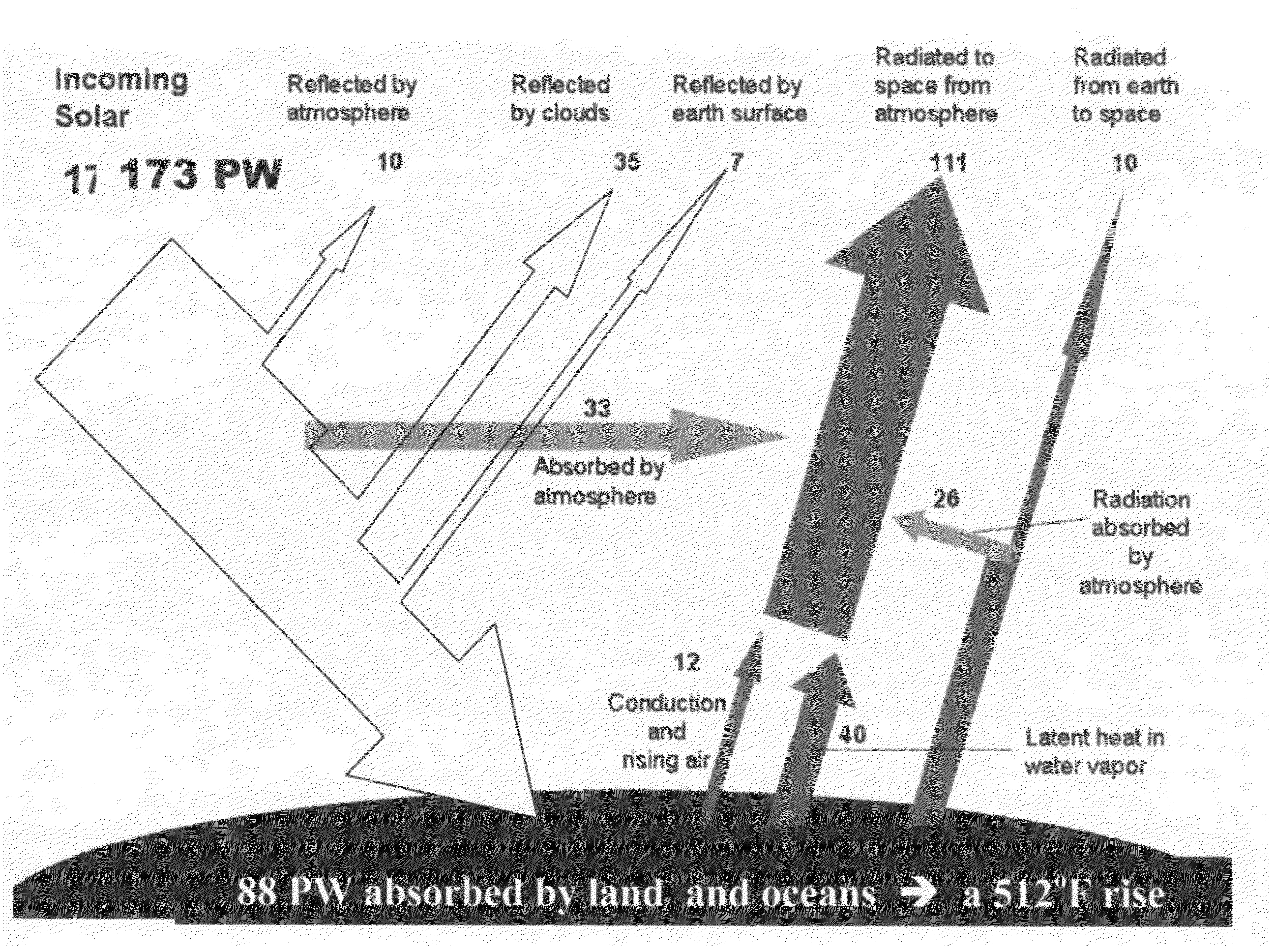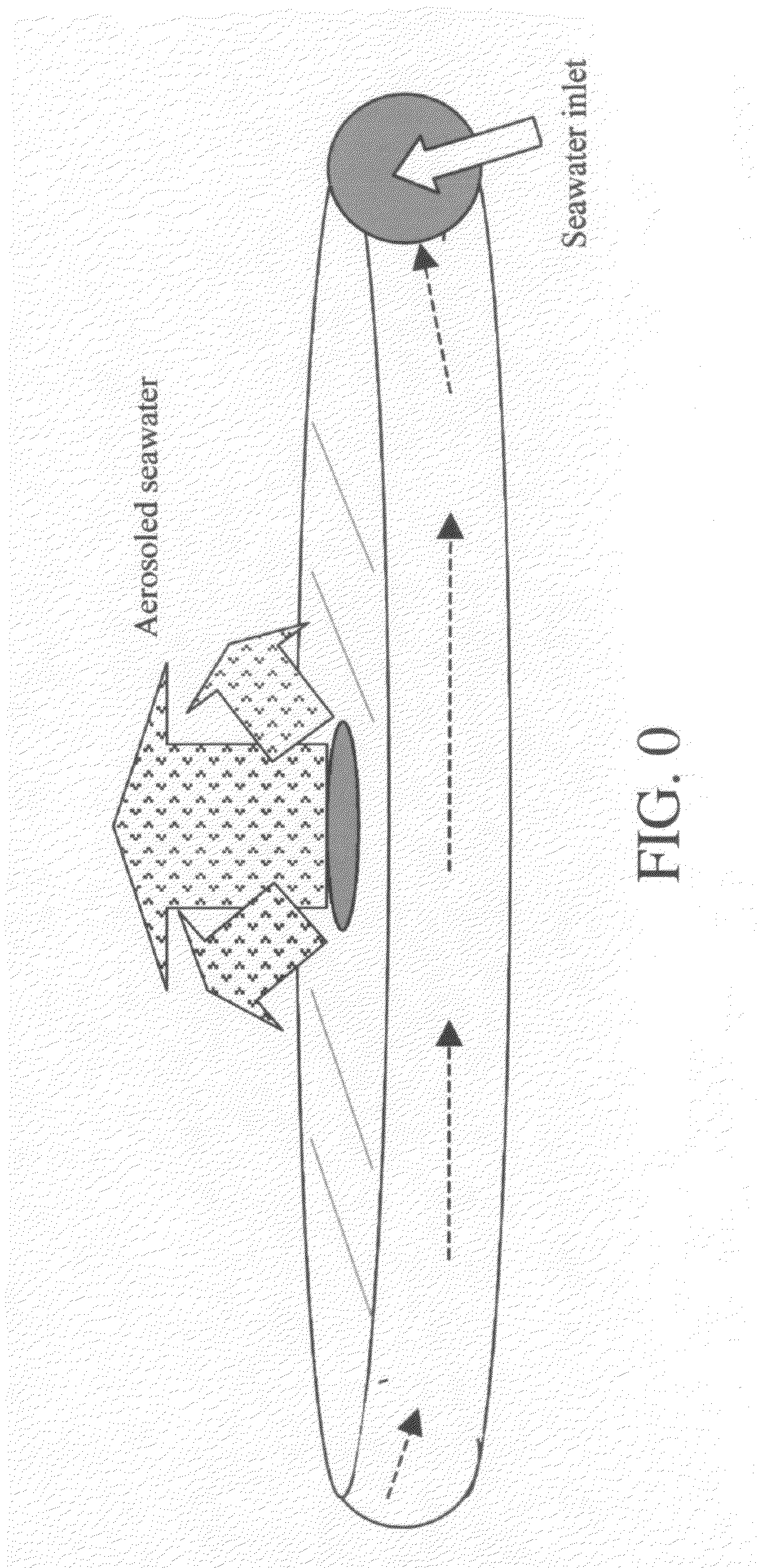Clean prime energy sources are still lacking.
Nuclear carries massive disposal and
radiation hazards.
Solar energy is the relentless and illusive prime energy option, which has almost no chance of becoming a prime source to meet man's needs without affordable macro
solar energy storage of this otherwise extremely intermit-tent solar energy.
The
list of proposed energy alternatives to reduce human global warming is very long.
However, they all completely ignore the far larger global warming issue—natural global warming, which is an issue at least 5 times greater than human global warming.
Unfortunately, the
fog vessel technology appears to contain grossly flawed assumptions.
Aside from the
fragility of such tall vessels against even modest winds, dangerous navigation to all sea vessels would result from
fog-impairment.
Greatly enlarged pontoons for durability against storms, would subject the vessels to ocean wave destruction and still fail to correct mere human global warming, not the much larger natural global warming problem.
Grossly incorrect
aerosol longevity assumptions (orders of magnitude errors), as well as other incorrect mathematical assumptions in ground-
fog generation, incorrectly conclude that only about 12 gallons per second per ship can cool the entire
planet.
The proposed high center of gravity ships cannot sustain even modest winds or ocean
waves without capsizing.
Furthermore, massive oceanic fog would impair
low altitude aircraft and especially sea navigation, leading to potential sea catastrophes.
Aside from the high cost (˜20 trillion) of orbiting millions of square meters of micron-thin mirrors (or one extremely large megaton mirror3), the task is mind-boggling and beyond known
space technology.
Visual and radio space telescopes would be impaired.
The “not reversible” aspect of mirrors is just one dangerous aspect.
Should unforeseen natural cooling take place on Earth, orbiting mirrors cannot be easily removed and excessive planetary cooling would be disastrous.
Thus, orbiting mirrors must be frequently replaced at full cost as the old ones fall or decay.
Inter-governmental cooperation is highly unlikely, given all the potential dangers and extreme costs of orbiting mirrors (or orbiting sun shades).
Here, like orbiting mirrors, the process is inherently very dangerous.
This sort of poorly conceived and even desperate “science” has generated disrespect for the term “geo
engineering”.
But the water
tower has only limited volumetric capacity—far too little thermal BTU capacity to continuously space-cool all the buildings that it serves.
Thermal losses within such massive un-insulated water towers are surprisingly small.
And finally, the plumbing-thermal-losses during pumping of either cold or
warm water to and from water towers, are also surprisingly small.
There simply is not enough water-flow in the pipes, especially at night, when little
potable water is consumed.
No new patent applications for either the “Time Wave”© or the constant temperature water-
tower enhancements are warranted.
Too few plants are surely detrimental.
It now appears that too many can be equally detrimental and that it is possible that too many clouds every 100,000 years can aid in creating an ice age.
If plants inhabited the many deserts and glacial lands, as they have in the past, they would hugely
impact Earth's hydrological cycle.
But as vividly illustrated in FIG. 3, the brief 150,000-year human inhabitation cannot explain millions of years of cyclic natural global warming and many ice ages.
However, we do know that big trees uniquely reach into the massive 15,300×1015 kg underground
fresh water aquifers (FIG. 10) and that Earth is definitely experiencing over-heating and
desertification.
That would not be true if Earth were too cold and required heating.
Aerosoling water into tiny droplets with great surface area for rapid
evaporation comes at a price in energy.
Any additional input energy is merely a result of device inefficiencies.
Higher water temperatures will decrease the theoretical minimum input energy to
aerosol water.
Seasons and weather also change the ideal operating conditions, and brief unfavorable
dew points can render macro evaporators ineffective.
Although some locations, like deserts, present very desirable
evaporation conditions most of the time, it is undesirable to concentrate many macro evaporators in one place, which can create undesirable local
weather patterns and weather-fronts.
Thus, great planetary cooling effects during winter seasons might appear to be undesirable or ineffective at first glance.
The melting polar ice is not being replenished with enough
snow—like the reduced
Mount Kilimanjaro
snow.
In most populated parts of the world, conventional space-heating is several times more expensive than space cooling.
Deep thermal storage will not significantly contribute to melting mini glaciers far above the hot sequestered solar energy.
However, one must compare this $450 million one-
time cost with
present day conventional space-heating costs sustained by 976,000 homes, which is typically $2 billion per year ($100 billion over a 50-year solar project life).
A one-time
solar field might cost only ˜1% of long-term conventional space-heating costs.
However, in the case of space-heating
cost savings, the absolute dollar savings (10's of billions of dollars) is much greater than space-cooling simply because heating is typically several times more expensive than cooling in most parts of the world.
Some reservoir real estate properties might not be large enough to accommodate an entire
solar field plus
ice storage acreage.
 Login to View More
Login to View More  Login to View More
Login to View More 


